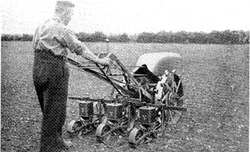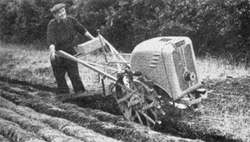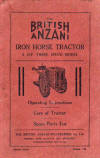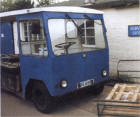|
Contents List
|
Queries
Barford Roller
Iron Horse
Milk Float
Ride-on Mower
The 'Dilly'
Does anyone remember a truck used by Goman
to teach auto mechanics 1955-58? It was used to haul hand tools and boys
to various parts of the college for work details on Saturdays for those who
didn't "do sports." I think it may have been a pickup or small truck
with wooden fence type sides.
Dave Turner (1951-58)
OK, so we have the "DILLY," but we now need to find the "TILLY." This was the name affectionately attached to the two Bedford Army Utility Estate Vans so madly driven by mad Stan Littlechild (Athlete & Singer) and gang ferrying super star athletes, football teams, cricket teams et al to the various venues around the county. Naturally khaki in colour and probably left on site by the Yanks. We found Dave's Bond Mini courtesy the man himself. Would really like to find a picture of the "TILLY" or "TILLYS."
David Spinks
Click to enlarge
This is something of a mystery picture, taken in the early 1960s. Dave Goman, Andy Seeley and an unidentified gentleman (Head Groundsman Ernie Snelling maybe?) are clearly pleased with this beast which, at a guess, has just been refurbished in the workshops. Was it used at the College? It would be interesting to discover the model and its date of manufacture. Can you help?
The name on the front of the radiator is 'Barford' - a Company that has a long history manufacturing road and grass rollers, both in association with other Companies, such as Perkins and Aveling, and (latterly) independently. Thomas Aveling built his first steam roller in 1865, and during the ensuing years his Company produced more steam rollers than all other makers combined. A competitor, Barford & Perkins, of Peterborough, introduced petrol and paraffin rollers into their product range in 1904, followed by diesel rollers in 1927. The two Companies finally merged in 1934 to form Aveling-Barford Ltd. (Grantham) and Perkins detached to continue manufacture of engines in Peterborough.
These messages were received in August 2006:
"I am not an old student, but have just seen on your website the picture of the Barford roller which I found during a search for Barford Perkins rollers. I have just got hold of one exactly the same, and am trying to research it. Mine is dated 1929, and it is actually a Barford Perkins. Apart from that I don't know any more; hence searching the web. Apparently they merged with Aveling in 1933, so that dates your roller pre-1933. Rollers this size became popular in semi-retirement for cricket clubs and grounds maintenance. In fact, mine came from a cricket club."
"I have found out that they are both "Pioneer" rollers. A similar, but not the same one, from 1933 for sale at a specialist antique machinery dealers was up for £1000 last week, and the the dealer told me there were quite a few around still - he thought about 20! Quite a bit of history really.
Loic Flory
A search of the internet reveals little, but a similar roller has pride of place at Sydney (Australia) Cricket Ground (SCG) .....
 |
"The 1924 Barford & Perkins roller has
recently been returned to its original glory through painstaking
restoration work by the Grounds and Maintenance teams, under the
guidance of mechanic, Arthur Cilia. The 2.5 ton roller from
Peterborough, England, arrived by ship in 1926 to replace, legend
claims, "Boxer," an ancient horse which towed a sandstone roller up and
down the square for years with carpet bound to its hooves to protect the
pitches. It has been in regular use at the SCG ever since.
The project started as a minor upgrade, but developed into a labour of
love for the Grounds and Maintenance teams, who take great pride in
their role in preserving the history of the Sydney Cricket Ground." "Cilia replaced some of the engine parts, polished up a tractor seat, turned the original wooden seat into a tool box, and installed a brass plate for Test captains' signature inscriptions. Steve Waugh and Shaun Pollock were the first captains to sign their names for posterity." |
Click to enlarge
This photo was taken c1954 and shows Dave Goman, Miles Baron and a group of 3rd Form students (the 1951 1st Form intake) admiring the out-shopped Anzani 'Iron Horse.'
It was introduced in 1940 by the British
Anzani Engineering Co. at Hampton Hill in Middlesex, as ‘the agricultural
machine built with aero engine accuracy’ and was fitted with a 4 stroke 6hp
Anzani/JAP air-cooled engine, oil bath air cleaner and Wico magneto. A
centrifugal clutch engaged the drive to the steel wheels through a three
forward plus reverse gearbox when the engine reached a speed of 750 rpm,
giving a top speed of 4 mph.
Hand-lever-operated independent dog clutches in the drive to the wheels
enabled the Iron Horse to make very sharp turns.
Caution was required, as the engine power could swing the handlebars round
with some force and easily knock the operator off his feet. Spade lug
wheels were standard equipment and track width was adjustable from 24 to 36
in. for ploughing and row-crop work. Optional extras included a side-mounted
belt pulley suitable for a saw bench and other stationary equipment. The
British Anzani Iron Horse cost £107-16s-0d in 1940, and pneumatic tyres were
an extra £10; the price had increased to £130 by 1945.
It was also possible to purchase a ride-on carriage for the driver to turn it into a normal tractor, capable of pulling farm carts with up to a ton load. A range of accessories increased its functionality with attachments for mowing, ploughing, spraying, hoeing, crop lifting and harrowing. It also had a multi-functional belt-driven power take-off system which provided farmers with additional tools that were continually developed and added to over the years, including saws, concrete mixers, pumps and electrical generators.
Hire purchase terms for the British Anzani in 1948 required a £35 deposit with two years to pay the the balance. Alternatively the Iron Horse and a selection of implements could be hired for £3-10s-0d per week."
"I remember the Gardens, loosely termed
Agricultural Science, and struggling with the Anzani Rotovator. Was it
“Big” Jim Long who had his arm broken when the starting handle “kicked back”
as he was trying to start the engine? We had to double dig the potato
‘field’ and later picked up the sharp stones from the newly established
playing fields. No rugby in those days, too many stones!" - Derek
Buckingham
Miles Baron's experiences with the Iron
Horse in the College garden are recounted in the Anniversary Book 'Wymondham College - The First
50 Years' by Roger Garrard and Michael Brand.
Background information was provided by
the
British Anzani Archive
and
Donald's
Antique Rototiller web sites.
Click to enlarge
This vehicle was spotted on a recent visit to the College and the photo, with no related text unfortunately, was found in the 2001 College Magazine. It's shown parked next to the support services office (the old workshops), so the function is probably to provide a light removals service.
"That milk float was replaced during the summer hols last year - we now have a practically identical, but slightly newer one. There's also a secondary milk float, used mostly by the refectory for moving food around - it's completely white and is more like a big electric van than a milk float."
Josh Smith (Kett Yr 10 - 2006)
Click to enlarge
Here's an untitled photo from the 2001 College Magazine. If you know who the guys are, please get in touch.
"Looks like a 'ride-on' 3-gang mower (Ransomes?) with the right side 'gang' lifted." - Inmate from the days of tin
Click to enlarge
This general-purpose 'lift and shift' vehicle was photographed in 1994 when its driver, Eric Roper, retired after 10 years as maintenance officer. The photo was taken in the maintenance area to the North of Kett Hall. The last surviving 'staff chalet' is in the background.
In May 2006 we heard from machinery enthusiast Simon Maltby who had recently bought something similar for £50 from a scrap yard. It bore the label 'Martin Trucks' and a little research has revealed that the Company is still going (based in Shrewsbury) and had previously taken over a similar outfit 'Bonser Trucks.' These little trucks appear to have had a manual tipping body, 3 forward and 1 reverse gearing, drum brakes on both rear wheels and a Villiers engine.
Is it still at the College?
Wymondham College Remembered








